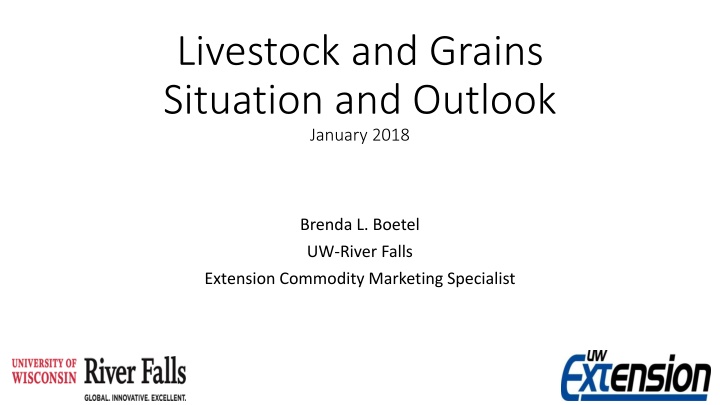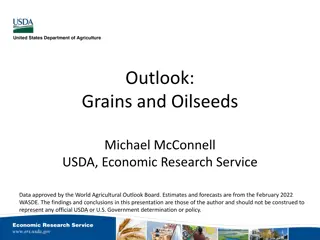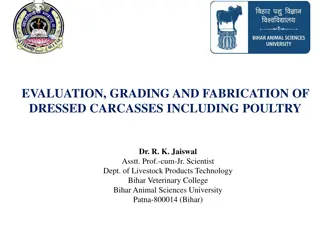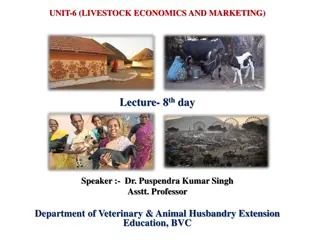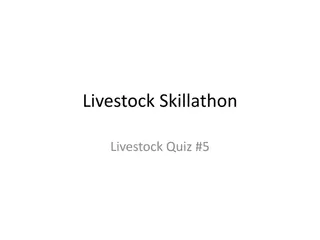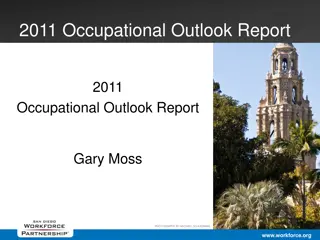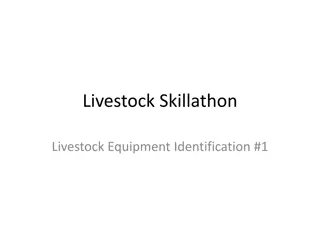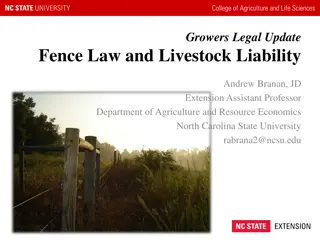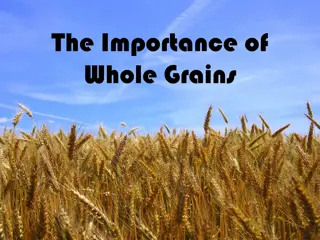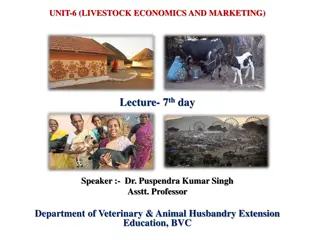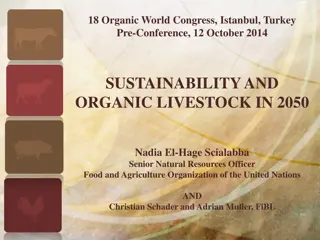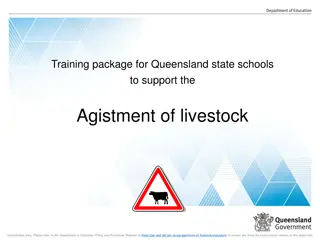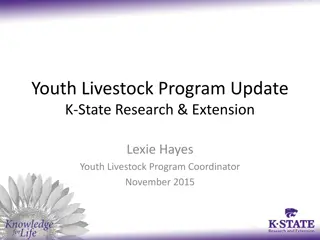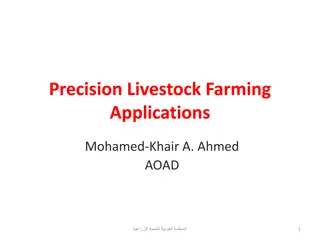Livestock and Grains Situation and Outlook Analysis for January 2018
Brenda L. Boetel, a Commodity Marketing Specialist, evaluates the Livestock and Grains situation for January 2018. The analysis covers key aspects such as Commercial Meat & Poultry Production, Meat Disappearance in the US, Pork Production, Beef Export Trends, and Future Predictions for the Cattle Industry. Detailed insights include record-setting production figures, export statistics, and projections for beef, pork, and poultry sectors.
Download Presentation

Please find below an Image/Link to download the presentation.
The content on the website is provided AS IS for your information and personal use only. It may not be sold, licensed, or shared on other websites without obtaining consent from the author.If you encounter any issues during the download, it is possible that the publisher has removed the file from their server.
You are allowed to download the files provided on this website for personal or commercial use, subject to the condition that they are used lawfully. All files are the property of their respective owners.
The content on the website is provided AS IS for your information and personal use only. It may not be sold, licensed, or shared on other websites without obtaining consent from the author.
E N D
Presentation Transcript
Livestock and Grains Situation and Outlook January 2018 Brenda L. Boetel UW-River Falls Extension Commodity Marketing Specialist
COMMERCIAL MEAT & POULTRY PRODUCTION By Type of Meat, Annual Bil. Pounds Thousands 100 80 60 40 20 0 1994 1996 1998 Beef 2000 2002 2004 Lamb & Veal 2006 2008 2010 2012 2014 2016 2018 Pork Chicken Turkey Meat production was up 2.5% in 2017 and will be up 2.8% in 2018 Broiler production up 2.1% (+1.8% in 2018) Turkey production down 0.3% (-1.9% in 2018) Pork production up 2.5% (+3.7% in 2018) Beef production up 3.8% (+4.9% in 2018)
Accounts for 51% of meat disappearance in US 2018 will be 5th consecutive year of record setting production Poultry supplies were 0.2 lb/capita smaller due to lower turkey production Adding poultry slaughter capacity Increase production Increased reliance on exports 2017 exported 16% of production Up approx. 1% over 2016 Mexico (-10%) big export market
4th year of record production 2017 production up 0.8 lbs/capita 2018 up 1 lb per capita Export 21% of pork production +3.9% in 2017, +4% in 2018 2014 US exported 6.7% more weight than EU 2017 US exported 2.5% less weight than EU 7% less to Japan 17% increase to Mexico 24% increase to S. Korea
Beef production will grow faster than pork or poultry Record production in 2018 (+3.8% in 2017, 4.9% in 2018) Cattle herd will be up 650K to 94.2 million Herd growth will remain at expansion levels
Beef Exports (+11% in 2017, +6% in 2018) Japan +28% in 2017 Canada +2.3% Mexico +7.5% South Korea +6.1% Where do US Beef Exports go? Japan 30% South Korea 22% Hong Kong 14% Mexico 14% Canada 8%
Where are we headed? Cattle price outlook should be viewed as having potential to be much different than expectations shown here. Feeding industry will remain current, but carcass weights will continue to increase Loss in currentness will push feeder and calf prices lower Expansion markets favors industry participants closer to the end user Retail beef price will fall more than expansion beef production Growing beef supplies but limited packer capacity means increased packer bargaining power
Where are we headed? Feeders saw record profitability in 2017 Margins will shrink in 2018 Cow calf and feeder profitability will shrink Continued volatility 2018 will see increased cattle herd
2018 Prices Prod. Up Down Exports Up Price Direction Down Broilers Turkey Hog prices Q1 - down 1.2% Q2 - up 0.5% Q3 down 3.6% Q4 - down 5.6% Yearlings Q1 up 13.6% Q2 - down 1.5% Q3 - down 8.1% Q4 - down 12.2% Q4 down 10.9% Pork Up Up Finished cattle Q1 - down 2.4% Q2 - down 7.7% Q3 - down 3.1% Q4 - up 4.6% Calves Q1 up 5.4% Q2 down 2% Q3 - down 3.9% Beef Up
Soybeans World production at 12.823 billion bushels US production - 4.392 BB Brazil production - 4.041 BB Argentina production 2.058 BB
Bullish Factors 2017/18 global demand is strong US Crush is up 2.5 MB from last year (projected up 10 MB for MY) Soybean Oil stocks are down 2% from October
Bearish Factors Despite strong crush meal and oil output is lower indicating lower quality Brazilian growing conditions have been good Brazilian consultants raise crop estimate US share of Chinese market has dropped to 30% USDA will likely revise projections lower China tightens import specifications on soybeans Only up to 1% FM Current #2 soybeans allow 2% FM
Total Commitments are down 15% to date Exports to China are down 26% to date USDA Projections Brazil will be up 6.9% US down 0.5%
US Corn Supply Total Supply = 16,947 Decreased corn acreage planted/harvested of 3.8 M Supply is stable YoY but demand is down 1% Carryover will increase 6.8%
US Ethanol Production Through first 3 months of MY, on pace to have 5.550 BB, up 25 MB than USDA projection Production decreased 58,000 bpd in December First time below last year since Aug 4 US exported 93.6 million gallons in October, up 7.2 million gallons (8.3%) from September Down 24.3% YoY Exports decreasing Shipments to Brazil lower after 20% tariff implemented and China implemented 30% tariff
US Corn Exports 2017/18 MY - commitments down 23%, outstanding sales down 15% Mexico commitments down 2.6%, outstanding sales down 15% Korea commitments down 60%, outstanding sales down 25% Japan commitments down 14.5%, outstanding sales up 10%
Bullish Factors Increased cattle on feed Slightly lower acres for 17/18 MY Bearish Factors Dry weather in Argentina and persistent La Nina effects Strong demand is already factored into price Weaker exports 21
Thoughts for 2018 and beyond Supply/demand concerns Large crops Corn markets have adjusted downward to absorb supplies Soybean market is still overpriced Limited upside potential for price To make a move up need bullish news, but to continue down need no new news
Where will prices go for 2018? Corn Dependent on acreage and mother nature Likely see a decrease in acreage Trend yield of 172.1 bu/acre Harvested acres of 82.5 M 14.3 BB production + 2.477 BB carryover + 40 MB imports = 16.794 BB supply Maintain current demand Stocks to use = 15.3% - current is 17.1% Cash prices would be similar to 2017 harvest price and potentially $0.10 higher
Where will prices go for 2018? Soybean Likely see an increase in acreage Trend yield of 47.6 Harvested acres of 90.2 M 14.3 BB production + 2.477 BB carryover + 40 MB imports = 16.794 BB supply Maintain current demand Stocks to use = 14.6%, current is 11% Cash prices could be as low as $8.46 at harvest
Things to watch in 2018 Argentina export tax decrease by 0.5% each month starting in 2018 This will increase export pressure from Argentina Value of dollar beginning to increase Economy at near full employment Wage growth is strong China? Importing less soybeans Changing specifications for soybean imports Leaving NAFTA? Talks begin Jan 23 Bilateral Talks
Thank you! Any Questions? Brenda.Boetel@uwrf.edu Data: LMIC, USDA-NASS, USDA-FAS
